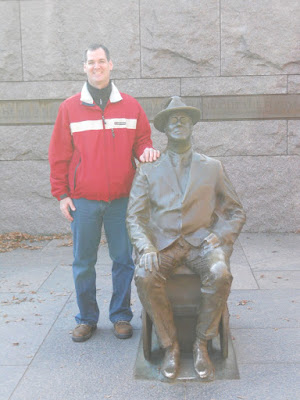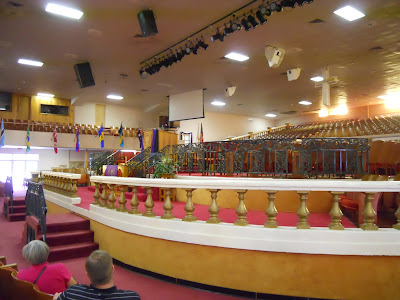
Our last day of touring was an amazing day in Memphis, Tennessee. Our first stop was another site that was not on our original itinerary, but I'm glad it was added. Mason Temple is the location of the Church of God in Christ's world headquarters and the location that Dr. King gave his last public speech on April 3, 1968.
It was here that Dr. King gave his "Mountaintop" speech. In the speech King seemingly prophesied his death. "I've been to the mountaintop...I've looked over and I've seen the promised land. I may not get there with you...." Absolutely haunting! The next day he was killed on the hotel balcony where he was staying.
A historic photo of King at Mason Temple on April 3, 1968.
One of my favorite stops was to the Stax Museum of American Soul Music. Stax recording studios was started in an old movie theater. Stax was named for a white brother and sister team, Jim Stewart and Estelle Axton, who began the studio. It would become the recording home of such musical stars as Issac Hayes, Otis Redding, the Staple Singers, Wilson Pickett, Booker T. and the MGs, and Sam and Dave.
The original music studio was torn down, but the museum and a youth music academy now keep the Stax story alive. Stax was an integrated label from the beginning and the music it produced almost magically seemed to break down racial barriers.
The Ike and Tina Turner exhibit.
The iconic Soul Train. The museum featured a huge screen that showed clips of the famed TV show with a dance floor in front that made you feel like you were a personal guest of show host Don Cornelius.
The Isaac Hayes exhibit. I was loving the gold platform shoes.
Isaac Hays's macked out Caddy.
Lunch was at Rendezvous, a Memphis landmark. The BBQ was excellent and the atmosphere even better.
Our last stop of the day was to the Lorraine Motel, which now serves as the National Civil Rights Museum. The museum has an impressive gallery that holistically covers the movement.

A wreath hangs on the balcony outside of Room 306 where Dr. King was killed.
The museum also owns the former boarding house across the street that was rented and used by convicted killer James Earl Ray.
Many people overlook why Dr. King was in Memphis when he was killed. He was there supporting the city's sanitation workers during a strike for better working conditions. On March 28, a demonstration had turned violent when looters broke windows of stores along the march route. Over 280 people were arrested and one man was killed.
One of the moving forces in Memphis that supported the sanitation workers was Rev. Samuel Kyles. In the picture above Rev. Kyles collects money in symbolic garbage cans at Mason Temple.
Dr. King was on the way to Rev. Kyles's home for supper when he was shot on the balcony of the Lorraine Motel. Rev. Kyles was beside Dr. King when the bullet struck.
While at the museum we were fortunate to get to meet and hear Rev. Kyles (center) recount spending the last minutes of Dr. King's life by his side.

























































